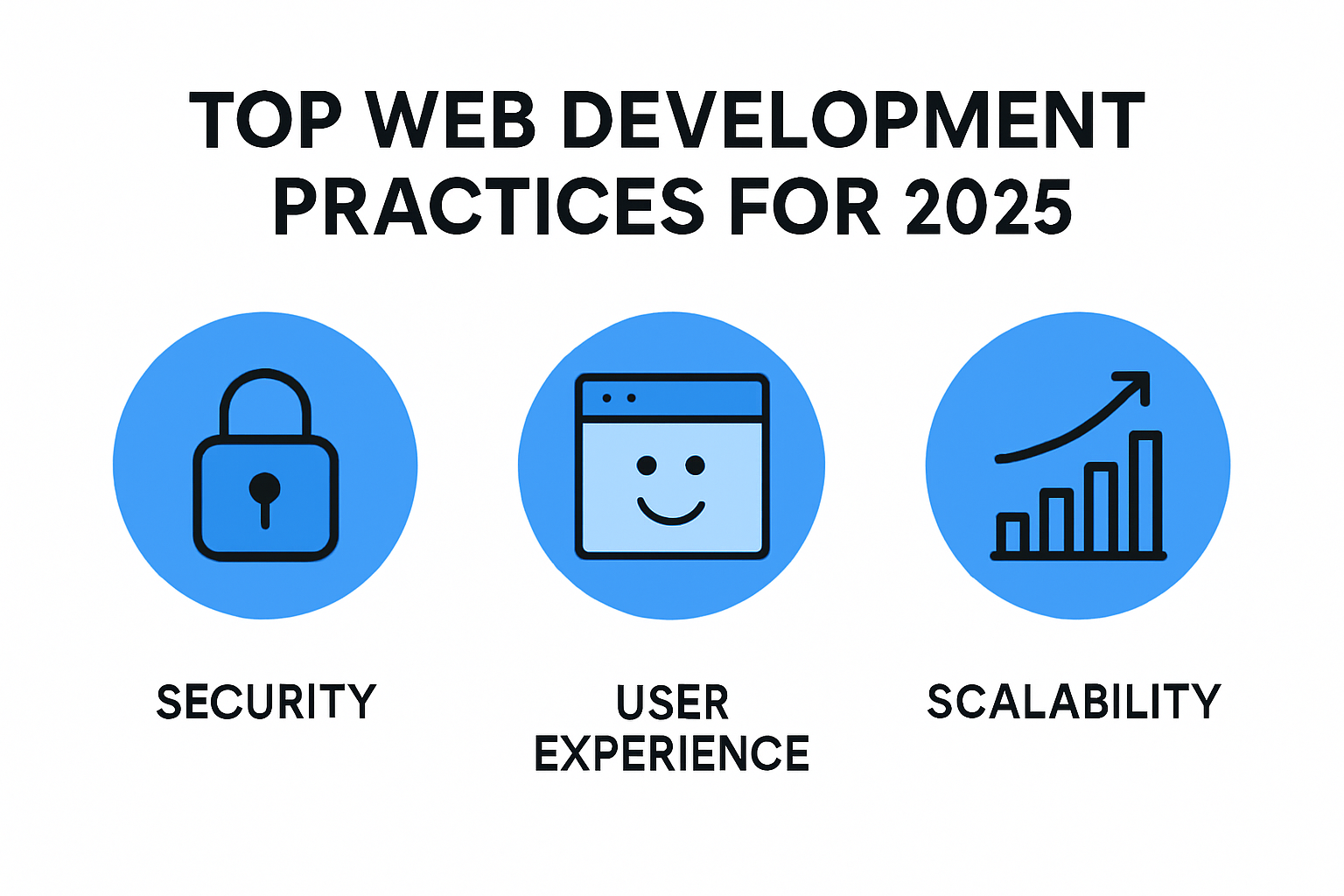Web development is changing fast and business leaders across South Africa are paying attention. Sites that load slowly or break on mobile are costing companies real money. But here is the shocker. Over 75 percent of users admit they will leave a website if it does not feel instantly usable or accessible. The big leap for 2025 is not just about fancy design or endless new features. It’s about building web solutions that are secure, friendly for all users, and ready to scale, no matter how quickly your business grows. Curious how the top web teams are pulling all this off? The answers may surprise you.
Table of Contents
- Building Secure And Scalable Web Solutions
- Improving User Experience And Accessibility
- Optimising Performance And Cloud Integration
- Ensuring Agile Development And Future Readiness
Quick Summary
| Takeaway | Explanation |
|---|---|
| Implement Holistic Security Measures | Prioritize a comprehensive security strategy throughout the entire development lifecycle for optimal protection against data threats. |
| Focus on User Experience Design | Create intuitive and accessible web interfaces, enhancing user interactions and engagement across diverse audiences. |
| Adopt Agile Development Practices | Utilize agile methodologies like CI/CD to promote flexibility, rapid updates, and quicker response to market changes. |
| Leverage Cloud-Native Technologies | Integrate cloud technologies allowing for scalable resources and improved operational efficiency to support growing digital needs. |
| Ensure Cross-Platform Compatibility | Design solutions that work seamlessly across different devices and browsers, ensuring a consistent user experience everywhere. |

Building Secure and Scalable Web Solutions
Web development in 2025 demands more than just functional websites. Businesses need robust digital solutions that protect sensitive data while supporting rapid growth and technological innovation. The key lies in creating web architectures that are simultaneously secure, scalable, and strategically aligned with business objectives.
Architectural Security Foundations
Secure web solutions start with a comprehensive approach to system design. The National Institute of Standards and Technology recommends integrating security principles throughout the entire software development lifecycle. This means moving beyond traditional perimeter-based security models to a more holistic strategy.
Key security considerations include:
- Threat Modeling: Proactively identifying potential vulnerabilities before they become critical risks
- Secure Coding Practices: Implementing rigorous development standards that minimize potential exploitation points
- Continuous Security Assessment: Regular vulnerability scanning and penetration testing to maintain robust defence mechanisms
Modern web solutions require adaptive security frameworks that can respond dynamically to emerging technological challenges. NIST SP 800-204C emphasizes the importance of service segmentation and network isolation, particularly for microservices-based architectures that support complex business applications.
To help readers compare foundational security practices, here is a summary table of key considerations and their purposes:
| Security Consideration | Purpose |
|---|---|
| Threat Modeling | Identify and mitigate vulnerabilities early |
| Secure Coding Practices | Reduce exploitation points through best coding practices |
| Continuous Security Assessment | Ensure ongoing protection with regular testing |
| Service Segmentation | Limit breach impact with isolated services |
| Network Isolation | Contain threats within network segments |
Scalability and Performance Optimization
Scalable web solutions are not just about handling increased traffic. They represent a strategic approach to digital infrastructure that allows businesses to grow without compromising performance or security. The ACM Digital Library research highlights critical architectural patterns that support high-performance, fault-tolerant web applications.
Effective scalability requires careful consideration of several technical dimensions:
- Distributed Architecture: Designing systems that can seamlessly distribute computational load across multiple servers
- Containerization: Implementing lightweight, portable deployment environments that enable rapid scaling
- Cloud-Native Technologies: Leveraging modern infrastructure that supports elastic resource allocation
Businesses must recognize that scalability is not a one-size-fits-all solution. Each digital ecosystem requires a tailored approach that considers unique operational requirements, anticipated growth trajectories, and specific performance benchmarks.
Strategic Security and Growth Integration
The most successful web solutions view security and scalability not as separate technical challenges, but as interconnected strategic capabilities. This means developing digital infrastructures that can:
- Protect sensitive business data
- Support rapid organizational growth
- Adapt to emerging technological landscapes
- Maintain consistent performance under varying computational demands
By adopting a holistic approach that integrates security, performance, and strategic flexibility, businesses can create web solutions that are not just functional, but truly transformative. The future of digital infrastructure lies in building smart, adaptive systems that grow alongside your business ambitions.
Ready to transform your digital strategy? Our team specializes in crafting web solutions that combine cutting-edge security with unparalleled scalability. Let’s chat about how we can future-proof your digital infrastructure.
Improving User Experience and Accessibility
User experience (UX) and accessibility are no longer optional features in web development—they are critical business strategies that directly impact digital success. In 2025, businesses must prioritize creating web solutions that are not only functional but also intuitive, inclusive, and engaging for all users.

Foundational UX Design Principles
The Nielsen Norman Group provides a comprehensive framework of usability heuristics that serve as fundamental guidelines for exceptional user experience. These principles emphasize creating digital interfaces that are immediately understandable, predictable, and user-friendly.
Core UX design strategies include:
- Visibility of System Status: Providing clear, immediate feedback about what is happening
- User Control and Freedom: Allowing users to navigate and interact without fear of irreversible actions
- Consistency and Standards: Maintaining uniform design language across digital platforms
Effective UX design goes beyond aesthetic appeal. It requires deep understanding of user behavior, cognitive load, and interaction patterns. Designers must anticipate user needs, eliminate unnecessary complexity, and create seamless digital journeys that feel natural and intuitive.
For a clearer view of the core UX design strategies, see the following table:
| UX Principle | Description |
|---|---|
| Visibility of System Status | Immediate, clear feedback about system actions |
| User Control and Freedom | Easy navigation and undo/redo options |
| Consistency and Standards | Uniform design across platforms for familiar interactions |
| Anticipating User Needs | Designing around expected user behaviour and preferences |
| Minimizing Complexity | Reducing cognitive load and making interfaces more intuitive |
Digital Accessibility as a Business Imperative
The World Wide Web Consortium’s Web Accessibility Initiative presents a compelling business case for digital accessibility. Accessibility is not just about compliance—it’s a strategic approach to expanding market reach and demonstrating corporate responsibility.
Key accessibility considerations encompass:
- Inclusive Design: Creating web solutions that work for users with diverse abilities
- Adaptive Technologies: Supporting screen readers, keyboard navigation, and alternative input methods
- Multilingual and Multicultural Support: Ensuring content is comprehensible across different linguistic and cultural contexts
Businesses that prioritize accessibility unlock significant competitive advantages. By removing digital barriers, they can engage broader audiences, improve brand perception, and create more robust, flexible web solutions.
Performance and Engagement Optimization
Modern user experience is intrinsically linked to performance. Slow-loading pages, complex navigation, and unresponsive interfaces can instantly discourage user engagement. Businesses must focus on creating web solutions that are not just accessible, but also lightning-fast and incredibly smooth.
Optimization strategies include:
- Responsive Design: Ensuring seamless experience across devices and screen sizes
- Performance Monitoring: Continuously tracking and improving page load times
- Personalization: Implementing intelligent interfaces that adapt to individual user preferences
The most successful web solutions in 2025 will be those that understand users as complex, diverse individuals with unique needs and expectations. By combining rigorous UX design, comprehensive accessibility, and performance optimization, businesses can create digital experiences that are genuinely transformative.
Want to elevate your digital presence with exceptional user experience? Our team specializes in crafting web solutions that are not just functional, but truly remarkable. Let’s discuss how we can make your digital platforms more engaging, accessible, and powerful.
Optimising Performance and Cloud Integration
Performance and cloud integration represent critical cornerstones of modern web development strategies. As businesses increasingly rely on digital infrastructure, the ability to create high-performing, scalable web solutions becomes a key competitive differentiator.
Cloud Architecture Fundamentals
The National Institute of Standards and Technology provides comprehensive guidance on cloud computing strategies that are essential for businesses seeking optimal web performance. Cloud integration is no longer just a technological choice—it is a strategic imperative that directly impacts operational efficiency and digital capability.
Core cloud integration principles include:
- Scalable Infrastructure: Designing systems that can dynamically adjust computational resources
- Resource Optimization: Implementing intelligent allocation mechanisms that minimize waste
- Multi-Region Deployment: Ensuring global accessibility and reduced latency
Successful cloud integration requires a holistic approach that considers not just technological capabilities, but also business objectives, security requirements, and future growth potential. Organizations must view cloud infrastructure as a flexible, adaptive ecosystem rather than a static technological solution.
Performance Optimization Strategies
IBM’s research publication highlights advanced techniques for web performance enhancement. Performance optimization in 2025 goes beyond traditional metrics, focusing on creating responsive, efficient digital experiences that adapt to complex user interactions.
Key performance optimization techniques encompass:
- Intelligent Caching: Implementing sophisticated caching mechanisms that predict and preload content
- Content Delivery Networks: Distributing computational load across geographically dispersed servers
- Dynamic Resource Allocation: Using machine learning algorithms to predict and manage computational demands
Businesses must recognize that performance is not a static achievement but a continuous process of monitoring, analyzing, and adapting digital infrastructure. The most successful web solutions will be those that can seamlessly balance performance, cost-efficiency, and user experience.
Strategic Cloud Integration
Cloud integration represents more than technological implementation—it is a strategic approach to digital transformation. Modern businesses require cloud solutions that are:
- Secure and compliant with evolving regulatory standards
- Flexible enough to support rapid technological innovation
- Cost-effective and aligned with specific business requirements
- Capable of supporting complex, distributed computational models
The future of web development lies in creating intelligent, adaptive cloud architectures that can respond dynamically to changing business needs. This means moving beyond traditional infrastructure models and embracing cloud-native technologies that support continuous innovation.
Ready to transform your digital infrastructure with cutting-edge cloud integration? Our team specializes in designing performance-optimized web solutions that grow with your business. Let’s explore how we can future-proof your digital strategy through intelligent cloud architecture.
Ensuring Agile Development and Future Readiness
In the rapidly evolving digital ecosystem of 2025, businesses must adopt development methodologies that prioritize flexibility, speed, and continuous innovation. Agile development and future readiness are no longer optional strategies but fundamental requirements for maintaining competitive advantage.
Agile Methodology and Continuous Deployment
Rapidops research highlights the critical importance of Continuous Integration and Continuous Deployment (CI/CD) practices. Modern web development demands a paradigm shift from traditional, lengthy release cycles to more dynamic, responsive approaches.
Key agile development principles include:
- Iterative Development: Breaking complex projects into manageable sprints
- Continuous Feedback: Implementing real-time collaboration and stakeholder engagement
- Rapid Prototyping: Creating minimum viable products for quick market validation
Agile methodologies enable businesses to deploy updates more frequently, reducing time-to-market and allowing rapid adaptation to changing technological and market landscapes. This approach transforms web development from a linear process to a flexible, responsive ecosystem.
Here’s a table summarising the core Agile principles, their benefits, and outcomes for businesses:
| Agile Principle | Benefit | Outcome |
|---|---|---|
| Iterative Development | Faster delivery of features | Quicker time-to-market |
| Continuous Feedback | Real-time input from stakeholders | Improvements aligned to business needs |
| Rapid Prototyping | Early testing and validation | Reduced development risks and quicker pivots |
Serverless Architecture and Scalability
IT Growth Labs research emphasizes serverless architecture as a transformative approach to web development. By eliminating infrastructure management complexities, businesses can focus on core product development and innovation.
Serverless architecture offers significant advantages:
- Automatic Scaling: Dynamic resource allocation based on real-time demand
- Cost Efficiency: Pay only for actual computational resources used
- Reduced Operational Overhead: Minimizing infrastructure management tasks
Businesses adopting serverless technologies can create more resilient, adaptable web solutions that can instantaneously respond to traffic fluctuations and evolving user needs.
Cross-Platform Compatibility and Innovation
Netguru’s comprehensive study underscores the importance of cross-platform compatibility in ensuring future readiness. Modern web solutions must function seamlessly across diverse devices, browsers, and technological ecosystems.
Strategies for ensuring comprehensive compatibility include:
- Responsive Design: Creating flexible interfaces that adapt to different screen sizes
- Automated Testing: Implementing robust testing frameworks across multiple platforms
- Progressive Enhancement: Building core functionality that works universally
Future-ready web development is about creating adaptable, resilient digital solutions that can evolve with technological advancements. This requires a proactive approach that anticipates change rather than merely reacting to it.
The most successful businesses will be those that view web development not as a one-time project, but as a continuous journey of innovation, learning, and strategic adaptation. By embracing agile methodologies, serverless architectures, and comprehensive compatibility strategies, organizations can build digital platforms that are not just functional, but genuinely transformative.
Ready to future-proof your digital strategy? Our team specializes in creating agile, innovative web solutions that grow and adapt with your business. Let’s discuss how we can turn your technological vision into a competitive advantage.
Frequently Asked Questions
What are the best web development practices for business growth in 2025?
A: The best web development practices for business growth in 2025 include implementing holistic security measures, focusing on user experience design, adopting agile development practices, leveraging cloud-native technologies, and ensuring cross-platform compatibility.
Why is user experience important in web development?
A: User experience is crucial in web development as it directly impacts user engagement, retention, and conversion rates. A well-designed and intuitive interface ensures that users can navigate the site easily, leading to higher satisfaction and loyalty.
How can businesses ensure their websites are secure?
A: Businesses can ensure their websites are secure by integrating security principles throughout the software development lifecycle, conducting regular vulnerability assessments, using secure coding practices, and implementing continuous security monitoring.
What is agile development, and why is it beneficial?
A: Agile development is a project management methodology that promotes iterative progress, real-time collaboration, and flexibility. It allows businesses to quickly adapt to changes, deliver updates more frequently, and improve overall responsiveness to market demands.
Supercharge Your Business Growth with Modern Web Development Solutions
Are you seeing your business website struggle to keep up with customers’ expectations when it comes to speed, security or seamless experiences across devices? The challenges discussed in the article — from holistic security and cloud integration, to user-centric design and agile updates — are never just buzzwords. They hold the key to driving your business expansion and staying competitive in South Africa’s fast-moving digital marketplace. If web development headaches like outdated infrastructure, poor scalability or confusing user journeys are blocking your growth, now is the ideal moment to make a change.
CloudFusion delivers custom-built web solutions that put all these best practices into action. You get cutting-edge website and app development tailored to your business goals, plus secure hosting, intelligent cloud strategies and end-to-end support. Whether you need a robust online platform, powerful branding or future-ready software, our team has the expertise to help you scale securely and confidently. See how our bespoke approach can reshape your business by visiting our Web Design and Development Quotation page. Take the next step today — claim your personalised consultation and let us turn your digital ambitions into business reality. For transformative results, start your journey at CloudFusion’s Solutions and discover the difference true expertise and partnership can make.








